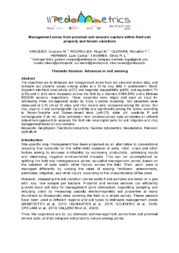Management zones from proximal soil sensors capture within-field soil property and terrain variations.
Management zones from proximal soil sensors capture within-field soil property and terrain variations.
Author(s): VASQUES, G. de M.; RODRIGUES, H. M.; OLIVEIRA, R. P. de; HERNANI, L. C.; TAVARES, S. R. de L.
Summary: The objectives are to delineate soil management zones from soil proximal sensor data, and compare soil property values among zones in a 72-ha crop field in southeastern Brazil. Apparent electrical conductivity (aEC) and magnetic susceptibility (aMS), and equivalent Th (eTh) and U (eU) were measured across the field by a Geonics EM38-MK2 and a Medusa MS1200 sensors, respectively. These properties were kriged and used as input for delineating three management zones by fuzzy k-means clustering. Soil properties were measured at 0-10 cm at 72 sites, and their means were compared among the zones. Soil clay, organic C and exchangeable Ca and Mg vary significantly among the zones, according to Brown-Forsythe and Games-Howell tests (p=0.05), while pH, available P and exchangeable K do not. Zone delineation from proximal sensor data constitutes an efficient data-driven approach to separate the field into meaningful parts for soil, irrigation and crop management based on soil variation.
Publication year: 2022
Types of publication: Paper in annals and proceedings
Unit: Embrapa Soils
Observation
Some of Embrapa's publications are published as ePub files. To read them, use or download one of the following free software options to your computer or mobile device. Android: Google Play Books; IOS: iBooks; Windows and Linux: Calibre.
Access other publications
Access the Agricultural Research Database (BDPA) to consult Embrapa's full library collection and records.
Visit Embrapa Bookstore to purchase books and other publications sold by Embrapa.

